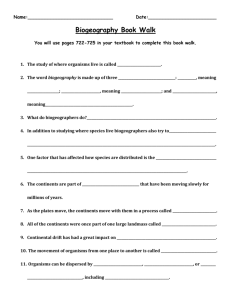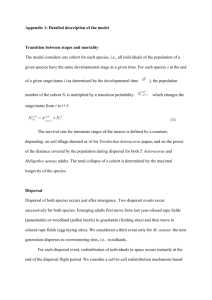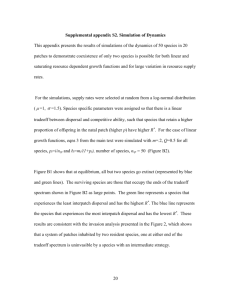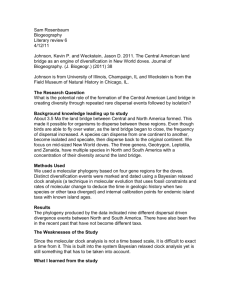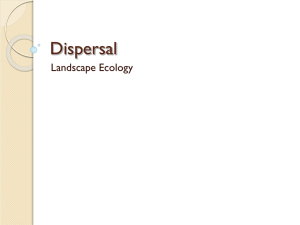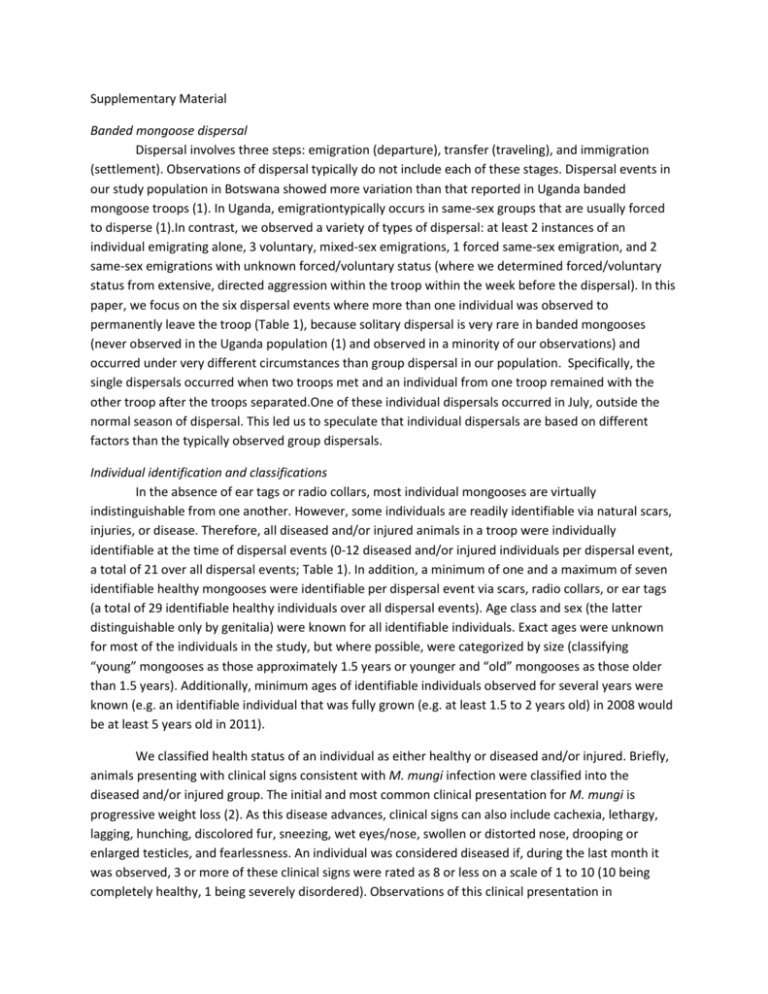
Supplementary Material
Banded mongoose dispersal
Dispersal involves three steps: emigration (departure), transfer (traveling), and immigration
(settlement). Observations of dispersal typically do not include each of these stages. Dispersal events in
our study population in Botswana showed more variation than that reported in Uganda banded
mongoose troops (1). In Uganda, emigrationtypically occurs in same-sex groups that are usually forced
to disperse (1).In contrast, we observed a variety of types of dispersal: at least 2 instances of an
individual emigrating alone, 3 voluntary, mixed-sex emigrations, 1 forced same-sex emigration, and 2
same-sex emigrations with unknown forced/voluntary status (where we determined forced/voluntary
status from extensive, directed aggression within the troop within the week before the dispersal). In this
paper, we focus on the six dispersal events where more than one individual was observed to
permanently leave the troop (Table 1), because solitary dispersal is very rare in banded mongooses
(never observed in the Uganda population (1) and observed in a minority of our observations) and
occurred under very different circumstances than group dispersal in our population. Specifically, the
single dispersals occurred when two troops met and an individual from one troop remained with the
other troop after the troops separated.One of these individual dispersals occurred in July, outside the
normal season of dispersal. This led us to speculate that individual dispersals are based on different
factors than the typically observed group dispersals.
Individual identification and classifications
In the absence of ear tags or radio collars, most individual mongooses are virtually
indistinguishable from one another. However, some individuals are readily identifiable via natural scars,
injuries, or disease. Therefore, all diseased and/or injured animals in a troop were individually
identifiable at the time of dispersal events (0-12 diseased and/or injured individuals per dispersal event,
a total of 21 over all dispersal events; Table 1). In addition, a minimum of one and a maximum of seven
identifiable healthy mongooses were identifiable per dispersal event via scars, radio collars, or ear tags
(a total of 29 identifiable healthy individuals over all dispersal events). Age class and sex (the latter
distinguishable only by genitalia) were known for all identifiable individuals. Exact ages were unknown
for most of the individuals in the study, but where possible, were categorized by size (classifying
“young” mongooses as those approximately 1.5 years or younger and “old” mongooses as those older
than 1.5 years). Additionally, minimum ages of identifiable individuals observed for several years were
known (e.g. an identifiable individual that was fully grown (e.g. at least 1.5 to 2 years old) in 2008 would
be at least 5 years old in 2011).
We classified health status of an individual as either healthy or diseased and/or injured. Briefly,
animals presenting with clinical signs consistent with M. mungi infection were classified into the
diseased and/or injured group. The initial and most common clinical presentation for M. mungi is
progressive weight loss (2). As this disease advances, clinical signs can also include cachexia, lethargy,
lagging, hunching, discolored fur, sneezing, wet eyes/nose, swollen or distorted nose, drooping or
enlarged testicles, and fearlessness. An individual was considered diseased if, during the last month it
was observed, 3 or more of these clinical signs were rated as 8 or less on a scale of 1 to 10 (10 being
completely healthy, 1 being severely disordered). Observations of this clinical presentation in
mongooses have only been linked to M. mungi infection (K. A. Alexander, unpublished data). We defined
injured animals as any individual presenting with a persistent (greater than 5 days) break in the skin,
persistent unusual swelling of any extremity (including the nose), and/or persistent limping.
We combined injured animals with diseased individuals rather than keeping them in separate
classifications in our analysis for three reasons. First, due to the apparent transmission of M.
mungithrough breaks in the skin, injured animals may be more susceptible to M. mungi invasion (2).
Thus, the potential impacts of dispersal on disease transmission in this system would apply similarly to
actively diseased animals and injured animals that are highly likely to become actively diseased within a
few months of injury. Second, the clinical signs of a chronic injury and the early clinical signs of TB
infection are similar (e.g. lethargy, lagging behind troop, reduced foraging, visible weight reduction) and
difficult to distinguish. Therefore, we could not accurately identify a specific time point that an animal
moved from a classification of injured into a classification of diseased. Third, injured animals that
became infected with TB did not show resolution of their injury; thus many individuals were classified as
both injured and diseased until death or disappearance, precluding us from categorizing them
separately.
Age and Sex Ratio Methods
If sex or age biases exist in dispersal rates or disease and/or injury rates, these biases could be
confounding factors when analyzing for the effects of disease and/or injury on dispersal. For example, if
young individuals are more likely to disperse than older individuals, but most diseased and/or injured
individuals are old, it would appear that disease and/or injury leads to a lower likelihood of dispersal,
while in fact the true factor affecting dispersal is age. Because of their large troop sizes, similarity in
appearance, and high activity level, it is extremely difficult to get an accurate count of a banded
mongoose troop that includes sex and/or age of all individuals. We therefore were unable to include sex
and age in the above statistical models of dispersal. However, because we had complete information on
age and sex of all diseased and/or injured individuals, we could examine whether a bias existed with
respect to the sex and age ratio of all diseased and/or injured individuals alive at the time of the
observed dispersal events.
We examined the potential for age to be a confounding factor in our data set. Among the
diseased and/or injured individuals available for dispersal, there was a biased age ratio (4 young, 16 old).
We used a Fisher’s exact test to determine if this age distribution of diseased and/or injured individuals
was similar to that present in the three troops with observed dispersal events. Age ratios for each troop
immediately before dispersal were not available, however we did have age ratios for these three troops
in the dry season of 2010, two to six months before the 2010 dispersals occurs (no births and few deaths
occur during the dry season). These age ratios were the only ones obtained for these troops in the 2010
dry season (thus, no “cherry picking” was possible). To test whether dispersed individuals were a biased
subset of a troop’s age distribution, we included in the Fisher’s exact test the age ratio of all identifiable
animals (regardless of health status) observed to disperse.Thus, this Fisher’s exact test determined if the
age ratio was the same among three groups: pre-dispersal diseased and/or injured individuals, predispersal troops, and recognizable dispersers.
Second, we determined if sex was a confounding factor in our analyses. We had no fine-grained
information on sex ratios in these troops, so we could not perform a test similar to the age test
described above. Among the diseased and/or injured individuals, there was no bias in the sex ratio (11
males, 10 females). Thus, with regard to sex, there was an unbiased pool of diseased and/or injured
individuals available for dispersal. However, if troops have strongly uneven sex ratios overall, and
dispersal is also sex biased, there could appear to be different dispersal rates between the two health
statuses that are actually due to differing sex ratios. We knew the exact dispersal rate for each sex
within each dispersal for diseased and/or injured individuals. For each dispersal, we calculated the
minimum possible dispersal rate for each sex for healthy individuals by determining the minimum
possible number of each sex, as well as the maximum number of dispersers of each sex. A one-tailed
Wilcoxon signed rank test was used to test whether the sex dispersal rates for diseased and/or injured
individuals was significantly less than the minimum sex dispersal rates for the healthy individuals.
Sex and age ratio analyses were performed with SAS JMP Pro (version 10.0.0; SAS Institute, Cary, NC;
2012) and α=0.05.
Age and Sex Ratio Results
We observed six dispersal events wherein a group of individuals permanently left a troop (Table 1). The
age bias present in diseased and/or injured individuals alive at the time of a dispersal event (20% under
1.5 years) was not significantly different from the age bias present in the troops during the 2010 dry
season (18.2-36.4%), nor was it significantly different from the age bias in identifiable animals that
dispersed (33.3%; Fisher’s exact test=0.0002, P=0.35).
The dispersal rate of each sex was always lower in the diseased and/or injured group, except for
two dispersals where no females dispersed regardless of health status. This difference in sex dispersal
rates was significant (1-tailed Wilcoxon signed rank test: P=0.31).
1.
Cant MA, Otali E, Mwanguhya F (2001) Eviction and dispersal in co-operatively breeding banded
mongooses (Mungos mungo). J Zool Soc London 254:155–162.
2.
Alexander KA et al. (2010) Novel Mycobacterium tuberculosis Complex Pathogen, M. mungi.
Emerg Infect Dis 16:1296–1299.



